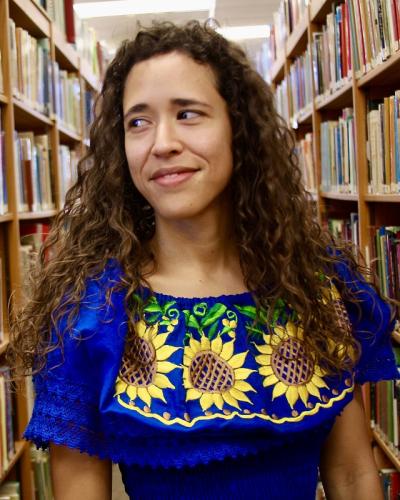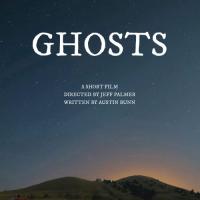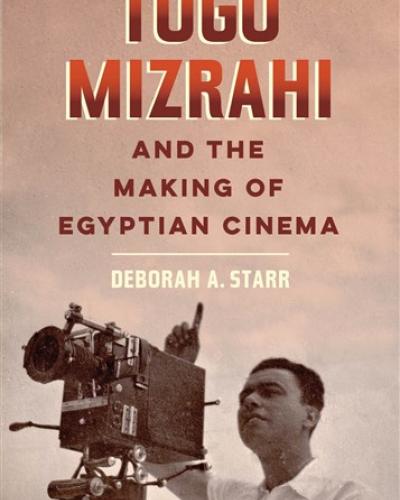Deborah Starr, Togo Mizrahi and the Making of Egyptian Cinema (University of California Press, 2020)
Originally Published On: https://www.jadaliyya.com/Details/42699/Deborah-Starr,-Togo-Mizrahi-and-the-Making-of-Egyptian-Cinema-New-Texts-Out-Now
Jadaliyya (J): What made you write this book?
Deborah Starr (DS): I find Togo Mizrahi’s story to be very compelling. Mizrahi was an Egyptian Jew with Italian nationality. One of the pioneers of the Egyptian film industry, he founded a studio and a production company in Alexandria in 1929. Mizrahi became a prolific director of comedies and musicals, working with many popular performers, including Umm Kulthum, Yusuf Wahbi, and ʻAli al-Kassar. He brought to the screen the Jewish comic actor Chalom (Leon Angel). Mizrahi also directed five films starring Egyptian Jewish singer Layla Murad, including Layla mumtira (A Rainy Night, 1939) and Layla (1942). All told, between 1930 and 1946, Togo Mizrahi directed thirty full-length feature films in Arabic and four Greek-language films.
While Mizrahi’s career as a filmmaker was exceptional, the arc of his personal narrative was typical of the experiences of Egyptian Jews. In the mid-twentieth century, as the political tides shifted, Togo Mizrahi left Egypt. In the 1960s, his production company was sequestered, and his property seized. Over the following decades, even though his films remained popular, his legacy faded alongside the memory of Jewish history and culture in Egypt. Writing this book, I set out to recuperate the life and work of this important filmmaker.
I propose alternative models for defining Egyptian cinema as a national cinema without nationality.
J: What particular topics, issues, and literatures does the book address?
DS: In the 1930s and 1940s, the film industry employed Egyptians of all religions as well as non-citizen residents—including minorities who held foreign citizenship, former Ottoman subjects from the Levant, and Europeans. There has been a lot of handwringing over how to define what is “Egyptian” about locally produced movies in this period. I categorically reject the common—but historically and theoretically problematic—approach of delimiting Egyptian cinema by participants’ nationality. For starters, in historical terms, a variety of factors contribute to a complex and unstable construction of nationality in Egypt at that time, particularly for Egyptian Jews. In the book, I propose alternative models for defining Egyptian cinema as a national cinema without nationality. I analyze institutions that shaped the development of the Egyptian film industry, as well as cinema professionals’ self-identification with Egyptian nationalist projects.
Mizrahi, like many other Egyptian filmmakers in the 1930s and 1940s, saw himself engaged in a project of national importance. Filmmakers, critics, and audiences alike viewed locally produced cinema as a source of national pride. Egyptian audiences wanted locally produced entertainment. Cinema professionals promoted local cinema as a way to combat foreign cultural domination. Egyptian film histories have tended to focus on the establishment of Studio Misr in 1934, but overlook the contributions of independent studios in this period and their shared nationalist agenda. I see this book as a correction to that oversight.
Contemporaneous critics praised Mizrahi for both the quality of his films and for his contributions to building the Egyptian cinema industry. In the 1930s, Mizrahi was involved in attempts at forming industry syndicates to agitate for state protection of the nascent Egyptian film industry. Later in his career, Mizrahi took to the press to raise public awareness of issues hampering the development of the Egyptian cinema industry. Mizrahi was both an artist and a businessman. When he called cinema houses to task in one of his columns, he urged them not only to screen more Egyptian films, but also to support a wider range of locally produced genres. Mizrahi saw himself as contributing to building both a local art form and a vital domestic industry.
In the book, I look closely at a number of Mizrahi’s films—from his early Chalom and ʻAbdu comedy Al-Manduban (The Two Delegates, 1934) to his final masterpiece, Sallama (1945), starring Umm Kulthum. I tease out the cultural and political implications of Mizrahi’s films, paying particular attention to the construction of pluralist nationalism, the representation of Jewishness, and the disruptive deployment of unstable gender categories in his films. In both comedies and musicals, Mizrahi utilized his films as a platform for addressing social issues, from income disparity to the changing roles of women in Egyptian society. Through my film analyses, I try to let Mizrahi speak through his art.
J: How does this book connect to and/or depart from your previous work?
DS: My previous research examined late-twentieth century literature and film that nostalgically represent intercultural contact in Egypt before the 1950s: between Muslims, Christians, and Jews; and between Egyptians, immigrants from (former) Ottoman territories, Italians, and Greeks. I wanted to understand the cultural environment that inspired such vivid nostalgia among late-twentieth century writers. In contrast to literature, cinema is inherently collaborative, and as I already stated, the industry was quite diverse. So, I began to explore how the narrative of coexistence played out in Egyptian cinema.
This project also reflects a theoretical shift in my approach to examining cultural exchange. In Remembering Cosmopolitan Egypt: Literature, Culture, Empire (Routledge 2009), I looked at the interrelationship between the colonial experience and the notion of the cosmopolitan. Togo Mizrahi and the Making of Egyptian Cinema reflects a turn away from cosmopolitanism toward the notion of the Levantine. In this book I examine the intersection between the diversity of the Egyptian film industry, the transnational nature of filmmaking, and the notion of the Levantine.
J: What do you mean by Levantine?
DS: I come to the term “Levantine” through the work of Egyptian-Jewish essayist, Jacqueline Shohet Kahanoff. Writing in 1950s and 1960s Israel, when fears of cultural admixture espoused by the Ashkenazi Zionist leadership were derogatorily dubbed “Levantinization,” Jacqueline Kahanoff embraced the term “Levantine,” and re-appropriated it. Drawing upon her experiences growing up in inter-war Egypt, Kahanoff saw the “Levantine” as a hybrid social formation, a force of cultural integration.
I found the notion of the “Levantine” an illuminating framework for reading early Egyptian movies, particularly when it came to making sense of the zanier farces of mistaken identity. I found that these films shared three common characteristics, what I call a “Levantine cinematic idiom.” First, Levantine films represent, and sometimes promote, an ethics of coexistence. Second, they utilize cinematic tools to construct a pluralist aesthetic. Finally, these films treat identity as fluid and mutable. Togo Mizrahi’s films involve convoluted plots of mistaken identity and play with notions of gender, race, and ethno-national identity. I use the concept of the Levantine to explore the potential of this indeterminacy. The Levantine ethics of coexistence evident in Mizrahi’s films takes aim at parochial nationalisms growing in popularity in Egypt at the time.
J: Who do you hope will read this book, and what sort of impact would you like it to have?
DS: Egyptian cinema has a huge international fan base. As I mention in the book, a copy of Mizrahi’s 1938 film ʻUsman wa-ʻAli (ʻUsman and ʻAli) starring ʻAli al-Kassar was viewed over a million times on YouTube. I am also aware that there is interest in Egypt and in other Arab countries, as well as among Mizrahi Jews, to learn more about the history and culture of Jews from Arabic-speaking countries. I wrote this book hoping to reach a broad range of readers interested in learning about the history of Egyptian cinema and the cultural production of Egyptian Jews. I was very happy to work with University of California Press to publish the book in their Luminos open access program; anyone, anywhere in the world can download and read the book for free.
In an academic context, I hope to reach audiences in the fields of Middle East studies, Jewish studies, and film studies. I see this book in conversation with the growing body of scholarship on intellectual, cultural, and artistic production by Jews from Arabic-speaking countries in the modern era. While this book focuses on Jewish cultural production in Egypt, the questions it raises about identity, nationality, and national belonging have implications for the broader field of Jewish studies. I was also delighted to have this book published in a new series that views Sephardi and Mizrahi studies as integral to the study of Modern Jewish histories and cultures. This book also fills a gap in cinema studies. Egypt is a major force in cinema production, with broad distribution in Arabic-speaking countries and beyond. Yet, there are very few book-length studies about Egyptian cinema published in English.
J: What other projects are you working on now?
DS: I anticipate sticking with 1930s Egyptian cinema for a while to continue exploring questions about race, gender, and nationality. While I was working on the racial issues raised by ʻAli al-Kassar’s performances in films directed by Togo Mizrahi, I became interested in the racialized persona of the Egyptian actor Koka—both in her appearances in Egyptian cinema, and the coverage in the Egyptian press of her appearance in the British film Jericho (1937) alongside African-American actor Paul Robeson. The assumptions reflected in the Egyptian offer insights into notions of race and identity in inter-war Egypt. I also plan to further explore fluidity of gender in the films of Assia Dagher.
Excerpt from the book (from Chapter 1, pp. 1-5)
We hear a band strike up festive music. We see street vendors selling their wares from carts lining a city street. A man and boy, holding hands, walk past the vendors. As they recede into a distant crowd, a pair of young men, both in Western suits and tarbooshes, stroll into and out of the frame. Two riders—one in a dark galabiya and tarboosh, the other in a light galabiya and turban—swing a gondola high into the air, cutting an arc across the screen. Young children circle by, riding on a carousel. Men push a manually operated fun wheel, as car after car filled with children rise and disappear out of the frame. A vendor tips a large, ornate brass carafe, and a translucent liquid pours out of the long spout in a wide curve, filling a glass. In a park, girls in light-colored dresses play chase. A pair of men in overcoats and tarbooshes walk along a path, followed by a group of boys who pause to peer at the camera. In the background, to the left, a woman in black wearing a face veil also looks in the direction of the camera. Behind them to the right, a man in a white galabiya and turban sits on the grass, deep in conversation. At the beach, a family walks along the shore—the distinctive seaside cabins and corniche of Alexandria visible to the right of the frame. People clustered in small groups picnic on the sand. The skirt hems of women dressed in the latest European fashion flap in the sea breeze along with the awnings of beach umbrellas.
This kinetic, carnivalesque montage appears in a 1937 Egyptian feature film, Al-ʻIzz bahdala (Mistreated by Affluence). A title screen identifies the celebration as “Shamm al-nasim, ʻid al-shaʻb”—that is, “Shamm al-nasim, the people’s feast.” Shamm al-nasim (“Smelling the Breeze”) —is a spring festival that shares some characteristics with other seasonal celebrations in the region, like Nowruz. Shamm al-nasim is also a uniquely Egyptian festival, with roots in ancient Egyptian practices. Egyptians take to the streets, parks, beaches, and green spaces.
The footage shows what appear to be Alexandria residents engaging in leisure activities in identifiable locales. None of the credited actors appear in the montage. Children display curiosity about the camera. The viewer is invited to read these images as authentic—even as we recognize the constructedness of the montage. Social codes of dress give the viewer cues to categorizing the individuals included in the footage. Members of the rising middle class—the effendiyya—are shown seeking entertainment and diversion alongside members of the popular classes. This carefully edited montage constructs a festival day in which Alexandrians across the socioeconomic spectrum celebrate in public spaces together.
While the celebration of Shamm al-nasim is pegged to the Coptic calendar, falling on the day after Easter, in modern times it has historically been celebrated by Muslim, Christian, and Jewish Egyptians alike. The narrative scenes that bracket the montage highlight this intercommunal aspect of the festival. In the scene preceding the montage, two families—one Muslim and one Jewish—prepare together for the next day’s feast. As the two mothers and their adult daughters package up the traditional Egyptian dishes they prepared for the picnic, the daughters’ fiancés deliver their contribution: fisikh, salted fish consumed on the holiday. In the scene that follows the montage, the two families picnic on the beach—literally breaking bread together. Read in tandem, the montage and the narrative scenes portray Shamm al-nasim as a universal practice of all Egyptians regardless of class or religion.
Mistreated by Affluence was written, directed, and produced by Togo Mizrahi, a Jewish native of Alexandria, and it stars a Jewish actor who performed under the screen name Chalom. Shamm al-nasim holds great appeal for Mizrahi; scenes from the festival feature prominently in three of his films, including Mistreated by Affluence. The holiday is both distinctly Egyptian, and universally celebrated in Egypt. The communal celebration of the festival enacts a pluralist vision of the Egyptian polity that Mizrahi projects in his films.
Another scene in Mistreated by Affluence also explores the intersection between coexistence and class. The protagonists—Chalom, a Jew; and ʻAbdu, a Muslim—start out impoverished and rapidly climb the socioeconomic ladder together, only to return to their modest circumstances after a fall. At the start of the film ʻAbdu is employed as a butcher’s assistant, and Chalom is an itinerant lottery-ticket seller. When the butcher dies, ʻAbdu unexpectedly inherits the shop. With this windfall, ʻAbdu rents the empty storefront next door for his friend. Chalom hangs a bilingual sign (Arabic and French) on his new shop. In Arabic, the sign reads “Chalom, for the sale and redemption of lottery tickets.” During the course of the film, the arabophone Chalom demonstrates at least a passing knowledge of Italian and Greek, but he does not speak French. So, when writing his sign, Chalom adopts an accessible model—the common signs for currency exchange in the port city. In contrast to the idiomatic French that appears alongside Arabic in the credits and intertitles of the film, the broken French in Chalom’s handwritten scrawl is difficult to decipher, reading as either “Chalom Agen d’echange” or “Chalom, Agen de Change”—Chalom, agent of exchange.
Like many of Mizrahi’s other popular comedies and musical melodramas of the 1930s and ’40s, Mistreated by Affluence features a convoluted plot of masquerade, role-play, and mistaken identity. In the film, Chalom exchanges identities as well as lottery tickets. As an “agent of exchange,” Chalom acts in ways that also set into motion the changes other characters undergo in the film. Plotted in this way, the film’s coexistence narrative serves to expose the nation’s “masquerade of unity.” The notion of exchange—from cultural exchange to exchange of identities—is a key element in Mizrahi’s films. Togo Mizrahi and the Making of Egyptian Cinema teases out the relationship between the notion of exchange and pluralist nationalism in Mizrahi’s oeuvre.
The storefront also is the site of an assertion of identity. In an earlier scene in Mistreated by Affluence, the camera pans by the vacant storefront next to the butcher shop where ʻAbdu is employed. Posters advertising Mizrahi’s 1933 film, Awlad Misr (Children of Egypt) plaster the closed grate of the empty shop. In the context of the coexistence narrative, the inclusion of the ad functions as a willful assertion of identity. The signs read “Togo Mizrahi presents Children of Egypt”—but the word “presents” is written in such small letters in both Arabic and French that it is barely visible. So, in the brief moment when the sign is visible, what catches the eye is “Togo Mizrahi” and “Children of Egypt.” Mizrahi, the Jewish director, wishes to identify himself, along with the Jewish character, Chalom—whose sign later graces the same shop—as children of Egypt. This book examines the place of Togo Mizrahi, “child of Egypt,” in Egyptian cinema history.
Togo Mizrahi was one of the most prolific filmmakers of his day; over the course of his productive sixteen-year career in the Egyptian film industry—from 1930 to 1946—he directed and produced thirty Arabic-language feature films, most of which he also wrote. In addition to his contributions to Egyptian cinema in Arabic, in his Egyptian studio he also produced four Greek-language films between 1937 and 1943.
The development of a local cinema industry was a source of national pride for Egyptian filmmakers, critics, and audiences alike in the midst of the anticolonial struggle. Mizrahi saw himself as engaged in this collective effort; and his contemporaries heralded his contributions to building a national film industry.
But Mizrahi, like many other Jews who lived in Egypt, never held Egyptian nationality. How did it come about that Mizrahi did not hold Egyptian nationality, even though his family could trace roots in Egypt back several generations? And how did an individual who did not hold Egyptian nationality come to identify with the Egyptian national struggle?





